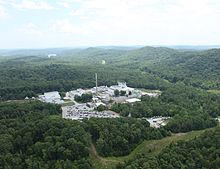
Back High Flux Isotope Reactor Czech Reactor de Isótopos de Alto Flujo Spanish Réacteur isotopique à haut flux French
The High Flux Isotope Reactor (HFIR) is a nuclear research reactor at Oak Ridge National Laboratory (ORNL) in Oak Ridge, Tennessee, United States. Operating at 85 MW, HFIR is one of the highest flux reactor-based sources of neutrons for condensed matter physics research in the United States, and it has one of the highest steady-state neutron fluxes of any research reactor in the world. The thermal and cold neutrons produced by HFIR are used to study physics, chemistry, materials science, engineering, and biology. The intense neutron flux, constant power density, and constant-length fuel cycles are used by more than 500 researchers each year for neutron scattering research into the fundamental properties of condensed matter. HFIR has about 600 users each year for both scattering and in-core research.

The neutron scattering research facilities at HFIR contain a world-class collection of instruments used for fundamental and applied research on the structure and dynamics of matter. The reactor is used for medical, industrial, and research isotope production; research on severe neutron damage to materials; and neutron activation to examine trace elements in the environment. Additionally, the building houses a gamma irradiation facility that uses spent fuel assemblies and is capable of accommodating high gamma dose experiments.
With projected regular operations, the next major shutdown for a beryllium reflector replacement will not be necessary until about 2023. This outage provides an opportunity to install a cold source in radial beam tube HB-2, which would give an unparalleled flux of cold neutrons feeding instruments in a new guide hall. With or without this additional capability, HFIR is projected to continue operating through 2040 and beyond.
In November 2007 ORNL officials announced that time-of-flight tests on a newly installed cold source (which uses liquid helium and hydrogen to slow the movement of neutrons) showed better performance than design predictions, equaling or surpassing the previous world record set by the research reactor at the Institut Laue–Langevin in Grenoble, France.[1]
- ^ Data suggest world record at Oak Ridge reactor, By Frank Munger, Knoxville News Sentinel, November 26, 2007
© MMXXIII Rich X Search. We shall prevail. All rights reserved. Rich X Search